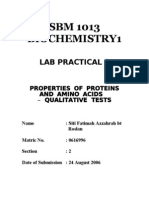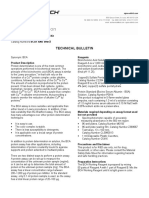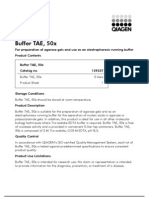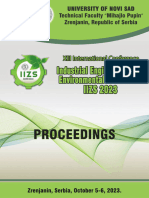Lab Report 5 FEER - Sem2
Lab Report 5 FEER - Sem2
Uploaded by
Feer NordinCopyright:
Available Formats
Lab Report 5 FEER - Sem2
Lab Report 5 FEER - Sem2
Uploaded by
Feer NordinOriginal Title
Copyright
Available Formats
Share this document
Did you find this document useful?
Is this content inappropriate?
Copyright:
Available Formats
Lab Report 5 FEER - Sem2
Lab Report 5 FEER - Sem2
Uploaded by
Feer NordinCopyright:
Available Formats
UNIVERSITI TEKNOLOGI MARA FACULTY OF CHEMICAL ENGINEERING ENGINEERING CHEMISTRY LABORATORY (CBE 461) NAME STUDENT NO GROUP EXPERIMENT
DATE PERFORMED : SEMESTER PROGRAMME / CODE SUBMIT TO : MOHAMED FIRDAUS BIN NORDIN : 2012867046 : EH 222 2A :ESTIMATION OF PROTEIN : 15/5/2013 :2 : EH222 / CBE461 : MISS NUR SHAHIDAH
No. 1 2 3 4 5 6 7 8 9 10 11 12 13
Title Abstract/Summary Introduction Aims Theory Apparatus Methodology/Procedure Results Calculations Discussion Conclusion Recommendations Reference Appendix TOTAL MARKS
Allocated Marks (%) 5 5 5 5 5 10 10 10 20 10 5 5 5 100
Marks
Remarks: Checked by: Date:
TABLE OF CONTENT CONTENT Abstract / summary Introduction Aims / objectives Theory Material and apparatus Procedure Result Discussion Conclusion Recommendation References Appendices PAGE
ABSTRACT
The estimation of protein can be done in three methods which are Lowry method, Biuret method, and Bradford method. Lowry method: Lowry method is use for determining the total level of protein in solution. The color change of the sample solution in proportion to protein concentration is how the total protein concentration is exhibited, which can then be measured using colorimetric techniques. It is named for the biochemist Oliver Howe Lowry who invented the reagent in the 1940s. Biuret Method: The Biuret Method, the most widely used method for the total protein estimation, depend on the complexation of Cu 2+ by the function groups involved with the peptide bond. At least two peptide bonds is needed for the complexation to occur. Upon complexation, a violet color will appear. The absorbance of the Cu 2+ -protein complex is measured at 540 nm and then compared to a standard curve. Bradford method:
The Bradford method which use Bradford assay is very fast and uses about the same amount of protein as the Lowry assay. It is accurate and retest of samples that are out of range can be done within minutes. The Bradford method is recommended for general use, especially for determining protein content of cell fractions and assesing protein concentrations. the composition of the assay include color reagent, protein standard, and instruction booklet are available from Bio-Rad Corporation.
INTRODUCTION Protein is made up from simpler molecule called amino acid. Amino acid varies in 20 different types such as alanine, leucine, and lysine. Proteins have complex shapes and folding in proteins happens spontaneously. Chemical bonding between portions of the polypeptide chain help the proteins to hold together and giving it its shape. Globular proteins and fibrous proteins are two general classes of protein. Globular proteins are generally compact, soluble, and spherical in shape. Fibrous proteins are usually elongated and insoluble. Globular and fibrous proteins may exhibit one or more of four types of protein structure. These structure types are called primary, secondary, tertiary, and quaternary structure. Proteins are essential parts of organisms and involve in virtually every process within cells. Many proteins are enzymes that help catalyze biochemical reactions and are important to metabolism. Proteins also are important in cell signaling, immune responses, cell adhesion, and the cell cycle. Through the digestion process, animals break down ingested protein into free amino acids that are then used in metabolism. Proteins can be be purified from other components using many techniques such as precipitation.
OBJECTIVES To study the method of assay preparation in protein estimation and to determine the best assay in protein estimation.
THEORY In this experiment, two absorption spectroscopy assays which is a colorimetric assay and spectrophotometric assay were performed to calculate the concentration of protein in samples by mere estimation of spectral absorption. These analytical techniques are grouped under the chemical method of spectrophotometry. For the colorimetric assay, Biuret, Lowry, and Bradford assay was used. The reagent can be used either qualitatively or quantitatively. All these three assay share a common principle which is, under alkaline conditions the divalent copper ion forms a complex with peptide bonds in which it is reduced to a monovalent ion (causing change in colours). Spectrophotometric analysis relies on the interaction of electromagnetic radiation (light) with the matter of interest. Strictly speaking, every compound has a distinct absorption spectrum which allows its identification, in many cases, in the presence of other compounds. In addition to the identification of a compound, it is also possible to determine quantitatively the concentration of that compound. The principle behind the Lowry method of determining protein concentrations lies in the reactivity of the peptide nitrogen with the copper [II] ions under alkaline conditions and the subsequent reduction of the Folin-Ciocalteay phosphomolybdicphosphotungstic acid to heteropolymolybdenum blue by the copper-catalyzed oxidation of aromatic acids. The Lowry method is sensitive to pH changes and therefore the pH of assay solution should be maintained around 10 - 10.5. The Bradford assay is very fast and fairly accurate and samples that are out of range can be retested within minutes. The Bradford is recommended for general use, especially for determining protein content of cell fractions and assesing protein concentrations. The assay is based on the observation that the absorbance maximum for an acidic solution of Coomassie Brilliant Blue G-250 shifts from 465 nm to 595 nm when binding to protein occurs. Both hydrophobic and ionic interactions stabilize the anionic form of the dye, causing a visible color change.
APPARATUS 1. Spectrophotometer 2. Pipette 3. Beaker 4. Cuvettes
MATERIALS 1. Biuret reagent 2. Lowry reagent 3. Bradford reagent 4. sodium carbonate 5. 0.4% NaOH 6. Folin-Ciocalteu phenol (folin) reagent 7. Distilled water 8. Protein:bovine serum albumin (BSA) and gelatin
PROCEDURE Estimation of protein 1) Lowry (reagent 1) 1 volume of reagent B is mixed with reagent A (50 volume) Reagent A 1) prepared 500ml 2) 2% NaCO2 (10g) is mixed with 0.4% NaOH (2g) 2) Lowry (reagent 2) 5ml folin is mixed with 5ml of distilled water
Analysis 1) Biuret - 1ml of protein is mixed with 5ml of biuret reagent (blank sample). It is measured 2) at 540nm.
Lowry - 0.5ml of protein is mixed with lowry reagent 1. After 10 minutes, 0.5ml lowry reagent 2 is added and mixed well. After 30 minutes, it is measured at 750nm.
3)
Branford - 0.5ml of protein is mixed with 5ml of Bradford reagent. It is measured at 595nm.
RESULT Table shows the absorbance of gelatin using 3 reagents; Biuret, Lowry and Bradfort.
Absorbance Biuret (540 nm) 0.00 0.08 0.09 0.10 0.20 0.30 0.40 0.00 0.106 0.317 0.314 0.327 0.338 Lowry (750nm) 0.00 1.464 1.515 1.372 1.704 2.037 Bradfort (595 nm) 0.00 1.716 0.979 0.61
Graph of the each of the absorbance of gelatin using 3 reagents; Biuret, Lowry and Bradfort.
Standart Curve of Gelatin for Biuret Reagent
0.45 0.4 0.35 absorbance (540nm) 0.3 0.25 0.2 0.15 0.1 0.05 0 0 0.1 0.2 concentration (mg/mL) 0.3 0.4 gelatin Linear (gelatin) y = 0.9929x + 0.1062 R = 0.5284
Standart Curve of Gelatin for Lowry Reagent
2.5 y = 2.6838x + 1.2051 R = 0.9313 2
Axis Title
1.5 Lowry Linear () Linear (Lowry)
0.5
0 0 0.05 0.1 0.15 0.2 0.25 0.3 0.35 Axis Title
Graph of Absorbance versus Concentration of Gelatin in Bradford reagent
2 1.8 1.6 1.4
Absorbance, nm
1.2 1 0.8 0.6 0.4 0.2 0 0 0.1 0.2 0.3 0.4 0.5 0.6 concentration of gelatin, g/mL Series1 y = 0.1808x + 0.7856 R = 0.0031 Series2 Linear (Series1) Linear (Series2)
Table below shows the absorbance of BSA using 3 reagents; Biuret, Lowry and Bradfort
Absorbance Biuret (540 nm) 0.00 0.08 0.09 0.10 0.20 0.30 0.40 0.50 0.00 0.046 0.232 0.261 0.301 0.316 Lowry (750nm) 0.00 1.933 2.912 2.935 3.067 3.163 Bradfort (595 nm) 0.00 2.037 2.054 2.218 2.917 2.96 3.11
Graph of the each of the absorbance of BSA using 3 reagents; Biuret, Lowry and Bradfort.
Standart Curve of BSA for Biuret Reagent
0.4 0.35 0.3 absorbance (540nm) 0.25 0.2 0.15 0.1 0.05 0 0 0.1 0.2 0.3 0.4 0.5 0.6 concentration (g/mL) Series1 Linear (Series1) y = 0.6783x + 0.0231 R = 0.8771
10
Standart Curve of BSA for Lowry Reagent
4 3.5 3 absorbance (750nm) 2.5 2 1.5 1 0.5 0 0 0.1 0.2 0.3 0.4 0.5 0.6 concentration (g/mL) y = 5.4971x + 0.9607 R = 0.7025
Series1 Linear (Series1)
Standard Curve BSA for Bradford Reagent
3.5 3 2.5 Axis Title 2 1.5 1 0.5 0 0 0.2 Axis Title 0.4 0.6 Linear (Absorbence Value (nm) Bradford) Absorbence Value (nm) Bradford Linear () y = 2.6412x + 1.9903 R = 0.7659
11
DISCUSSION This experiment is conducted by using three different assays which is Biuret, Bradford and Lowry assays to estimate two types of proteins used which are Bovine Serum Albumin (BSA) and gelatin. The proteins used is in different concentrations which are 0.08, 0.09, 0.1, 0.2, 0.3, 0..4 mg/ml for the gelatin and 0.08, 0.09, 0.1, 0.2, 0.3, 0.4, 0.5 mg/ml for BSA.
For Biuret assays, after its reacts with the gelatin and BSA sample, the absorbance for the different concentrations is determine using spectrophotometer set at 540nm and the data is tabulated and the graph is plotted. The steps were also carried out for Lowry assay and Bradford assay where the setting of spectrophotometer is 750nm and 595nm respectively. Based on the result obtained, the R2 obtain for the gelatin in Biuret assay, Lowry assay and Bradford assay are 0.5842, 0.9313 and 0.0031 respectively. Based from the theoretical, the experiments results are seem to be valid as it approaching 1 which is the theoretical value except for the last which is the Bradford assay. This undesired value may due to the impurities in the apparatus used. The proper cleaning of apparatus must be done before it is being used.
While for BSA sample, the R2 obtained are 0.8771 for Biuret assay, 0.7025 for the Lowry assay, and 0.7659 for the Bradford assay. Since the values approaching the value of the theoretical which is 1, the results obtain are all valid for BSA. Lowry assays is very sensitive to the tyrosine present in the protein. The reaction involves reduction of the Folin reagent and oxidation of aromatic residues mainly tryptophan and also tyrosine. Both BSA and gelatine contain the tyrosine in their composition.
Based on the theoretical results, the Bradford assay is said to be the best assay, which is should be showing the highest of the R2. However, due to the error while handling the experiment, the result obtained is far differ to the theoretical value.
12
CONCLUSION Overall, the results obtained for the BSA sample and the gelatin sample by the Biuret assay, Lowry assay and the Bradford assay are valid based on theoretical which show the value approaching 1. The assay that should give the highest value based on theoretical is Bradford assay, but in the gelatin sample, the Lowry assay has the highest R2 value which is opposite to the theoretical one. For the BSA sample, the same situations occur but the different is that the highest R2 value is for Biuret reagent. Based on experiment conducted, Lowry is the easiest assays to be prepared among all. From the theory, Bradford assays is the best in estimation of protein but based on experimentally observation, the best assays to used in this experiments is Lowry assays. As the conclusion, due to the criteria discuss based on the experimentally results, the best assays for protein estimation in this experiment is Lowry assays.
RECOMMENDATION 1. During the experiment, proper attire such as gloves, goggles and lab coat must be wear. 2. When doing experiment on gelatin, the procedure need to be done fast and very carefully because the gelatin will became more viscous. 3. Weigh the gelatin accurately because when it is dilute with water is became viscous and hard to detect the absorbance. 4. The value of absorbance must be taken repeatedly to ensure the consistency of reading. 5. Follow the laboratory regulation and rules throughout the experiment period. 6. Make sure all the apparatus clean and safe before using it.
13
REFERENCE 1. http://www.gbiosciences.com/ResearchProducts/Protein-Research/ProteinQuantificationAssays.aspx
2. http://www.vivo.colostate.edu/hbooks/genetics/biotech/basics/prostruct.html
APPENDICES
14
You might also like
- Protein Assay Using The Bradford Method: B. Procedure 1. Preparation of The SolutionDocument3 pagesProtein Assay Using The Bradford Method: B. Procedure 1. Preparation of The SolutionNaim Garcia MacasalongNo ratings yet
- Protein Assay by The Bradford MethodDocument4 pagesProtein Assay by The Bradford MethodKat Buenaflor100% (1)
- Bradford Protein Concentration Assay Formal ReportDocument4 pagesBradford Protein Concentration Assay Formal ReportAngeline Limpiada100% (1)
- Protein Assay Using Bradford MethodDocument3 pagesProtein Assay Using Bradford MethodRaymond Malubay100% (2)
- Lab 3 Biuret Protein AssayDocument9 pagesLab 3 Biuret Protein Assayapi-384770852No ratings yet
- Protein Assay Using The Bradford MethodDocument3 pagesProtein Assay Using The Bradford MethodTimmy CoNo ratings yet
- Lab Report Sds-Page WB - PT 1 (1-5)Document5 pagesLab Report Sds-Page WB - PT 1 (1-5)Ezad juferiNo ratings yet
- UK Guidelines Iron Deficiency in Pregnancy PDFDocument34 pagesUK Guidelines Iron Deficiency in Pregnancy PDFYoga Rhamada SiregarNo ratings yet
- LDH PurificationDocument24 pagesLDH PurificationFeynman Liang100% (1)
- Density of SteelDocument4 pagesDensity of SteelMongia MoghiNo ratings yet
- Bradford Formal ReportDocument4 pagesBradford Formal ReportAlyana100% (1)
- Exp 3 - Bradford AssayDocument7 pagesExp 3 - Bradford AssayracelanjelicaNo ratings yet
- The Bradford Method For Protein QuantitationDocument7 pagesThe Bradford Method For Protein QuantitationChemiboyNo ratings yet
- Bradford Protein Assay: Considerations For UseDocument4 pagesBradford Protein Assay: Considerations For UseRaja RajeshwariNo ratings yet
- Bradford ReportDocument7 pagesBradford ReportNOXOLO NOMBULELO WENDY NGXONGONo ratings yet
- Biuret AssayDocument6 pagesBiuret Assay门门No ratings yet
- Formal Report - BradfordDocument2 pagesFormal Report - BradfordAly Arcega100% (4)
- Lowry AssayDocument7 pagesLowry AssayGrace AquinoNo ratings yet
- Formal Report Bio Chem 1Document1 pageFormal Report Bio Chem 1yel_reyes100% (1)
- Quantitative Determination of Proteins Using Bradford MethodDocument2 pagesQuantitative Determination of Proteins Using Bradford Methodann_michelle7No ratings yet
- Biuret Protein Assay f18Document6 pagesBiuret Protein Assay f18new worldNo ratings yet
- Bradford Protein AssayDocument3 pagesBradford Protein AssayFarhan AhmadNo ratings yet
- Lab Report Exp.6Document8 pagesLab Report Exp.6Qj B PdkhNo ratings yet
- BCA Method of Protein EstimationDocument31 pagesBCA Method of Protein EstimationSwetha SundarNo ratings yet
- Sds PageDocument20 pagesSds Pageviswagithe s lNo ratings yet
- Determination of Protein Content SpectrophotometricallyDocument10 pagesDetermination of Protein Content SpectrophotometricallyTsabit AlbananiNo ratings yet
- Salting In, Salting Out and DialysisDocument3 pagesSalting In, Salting Out and DialysisAnju GuptaNo ratings yet
- High Pure Plasmid Isolation KitDocument17 pagesHigh Pure Plasmid Isolation KitiSaham MYNo ratings yet
- Sigma BCA Protein Assay ProtocolDocument6 pagesSigma BCA Protein Assay ProtocolssmaniNo ratings yet
- Biuret MethodDocument2 pagesBiuret MethodLarry LucianoNo ratings yet
- Buffer TAE SpecificationsDocument2 pagesBuffer TAE SpecificationsMuhammad Pawpaw FauziNo ratings yet
- The Analysis Techniques of Amino Acid and Protein in Food and Agricultural ProductsDocument8 pagesThe Analysis Techniques of Amino Acid and Protein in Food and Agricultural ProductsMashuri UtamaNo ratings yet
- Protein Lab ReportDocument7 pagesProtein Lab ReportFariha0% (1)
- The Biuret AssayDocument6 pagesThe Biuret AssayvictorNo ratings yet
- Analysis of Volhard's MethodDocument9 pagesAnalysis of Volhard's MethodKingsley WongNo ratings yet
- Biochem 313 Prac 5Document8 pagesBiochem 313 Prac 5Anonymous G8WVOfRqV100% (2)
- Total ProteinsDocument16 pagesTotal ProteinsAhmad Ripani Musyaffa AhdanLabNo ratings yet
- DNA Quality-Spectrophotometry and ElectrophoresisDocument5 pagesDNA Quality-Spectrophotometry and Electrophoresislovina candra kirana100% (1)
- Total Protein Determination: Unit Intended Learning OutcomesDocument12 pagesTotal Protein Determination: Unit Intended Learning OutcomesMaria ClaraNo ratings yet
- Starch HydrolysisDocument3 pagesStarch HydrolysisWiwit ArumNo ratings yet
- Quantitative Protein Analysis (Bradford's Assay)Document3 pagesQuantitative Protein Analysis (Bradford's Assay)Sean Herman100% (1)
- Report Reducing SugarDocument8 pagesReport Reducing SugarRedzuan Hussin83% (6)
- Assays For Determination of Protein Concentration PDFDocument32 pagesAssays For Determination of Protein Concentration PDFImanol Cuevas Medina100% (1)
- Assays For Determination of Protein ConcentrationDocument29 pagesAssays For Determination of Protein ConcentrationSam Joshva100% (1)
- Amylase Assay 2Document9 pagesAmylase Assay 2Rahman ImudaNo ratings yet
- Experiment 2 Isolation and Characterization of Proteins Protein Assay Using The Bradford MethodDocument7 pagesExperiment 2 Isolation and Characterization of Proteins Protein Assay Using The Bradford MethodCHRISTIN SCHLITTNo ratings yet
- Estimation of AlbuminDocument2 pagesEstimation of AlbuminAnand VeerananNo ratings yet
- Optimization of Cellulase Enzyme From Vegetable Waste by Using Trichoderma Atroviride in Solid State FermentationDocument6 pagesOptimization of Cellulase Enzyme From Vegetable Waste by Using Trichoderma Atroviride in Solid State FermentationIOSRjournalNo ratings yet
- Spectrophotometric Determination of Protein' ReportDocument4 pagesSpectrophotometric Determination of Protein' ReportAhmad Nabaz Khalil HamasalihNo ratings yet
- Experiment 37B-2 Spectroscopic Analysis of Dyes - More Than Pretty ColorsDocument5 pagesExperiment 37B-2 Spectroscopic Analysis of Dyes - More Than Pretty ColorsHEEBA SATHYANo ratings yet
- 02 Protein DigestionDocument44 pages02 Protein DigestionJohn MusaNo ratings yet
- Lab ReportDocument7 pagesLab ReportAlliedschool DefencecampusNo ratings yet
- Sds-Page: SDS-PAGE (Sodium Dodecyl Sulfate-Polyacrylamide Gel Electrophoresis) Is ADocument10 pagesSds-Page: SDS-PAGE (Sodium Dodecyl Sulfate-Polyacrylamide Gel Electrophoresis) Is ANTA UGC-NET100% (1)
- SDS-PAGE of Protein: BT 510 Analytical Biotechnology LabDocument6 pagesSDS-PAGE of Protein: BT 510 Analytical Biotechnology LabBarish RoyNo ratings yet
- Determination of Constant of Ionization of A Weak Acid by Spectrophotometry 5Document6 pagesDetermination of Constant of Ionization of A Weak Acid by Spectrophotometry 5mmmsaNo ratings yet
- Experiment 5 Carbohydrate CharacterizationDocument4 pagesExperiment 5 Carbohydrate CharacterizationPrince Robert Chua100% (1)
- DNA Isolation, Restriction, Visualitation, and QuantificationDocument20 pagesDNA Isolation, Restriction, Visualitation, and QuantificationSonianto kuddi100% (7)
- Introduction To SDS PAGEDocument8 pagesIntroduction To SDS PAGESukeshNo ratings yet
- Lab Report (Microbiology)Document12 pagesLab Report (Microbiology)RafiHunJian100% (1)
- The Bradford Method For Determining Protein ConcentrationsDocument9 pagesThe Bradford Method For Determining Protein ConcentrationsClarisa Sutherland100% (1)
- Biochemistry Control Serum (Human) : Level: II Lot: 033 EnglishDocument2 pagesBiochemistry Control Serum (Human) : Level: II Lot: 033 EnglishFirman FirjaNo ratings yet
- Applied Physics Notes-Unit-2Document17 pagesApplied Physics Notes-Unit-2medhadhruthiNo ratings yet
- Hydrothermal Carbonization of Industrial Mixed SludgeDocument7 pagesHydrothermal Carbonization of Industrial Mixed SludgeIssaoui MansourNo ratings yet
- Chemical EngineeringDocument14 pagesChemical EngineeringPreet PrashantaNo ratings yet
- Physics Reference Manual GEANT4Document572 pagesPhysics Reference Manual GEANT4ForeverSleepingNo ratings yet
- PQR As Run SheetDocument2 pagesPQR As Run SheetAhmed ElsharkawNo ratings yet
- Crystallographic Texture of MaterialsDocument265 pagesCrystallographic Texture of MaterialsADABALA SUBRAHMANYAMNo ratings yet
- Lecture-1 (Atomic Structure)Document16 pagesLecture-1 (Atomic Structure)Shahriar ShamsNo ratings yet
- Detection of Extra Elements in The Organic CompoundDocument3 pagesDetection of Extra Elements in The Organic CompoundBilNo ratings yet
- Aquasorb OZ - Antiozonates Softner For Denim Fabrics.Document11 pagesAquasorb OZ - Antiozonates Softner For Denim Fabrics.L.N.CHEMICAL INDUSTRYNo ratings yet
- Physics 73.1 Syllabus Midyear 17Document4 pagesPhysics 73.1 Syllabus Midyear 17Clara OgladitNo ratings yet
- Repcon SDocument2 pagesRepcon SRamu SekarNo ratings yet
- Module 3Document19 pagesModule 3Ratay EvelynNo ratings yet
- Data Driven Formulation Development Using Material Sparing MethodsDocument55 pagesData Driven Formulation Development Using Material Sparing MethodsMostofa RubalNo ratings yet
- Stirling CryocoolerDocument7 pagesStirling Cryocooler111Neha SoniNo ratings yet
- 15 WearDocument22 pages15 WearqwertgyhuxNo ratings yet
- IIZS 2023 Proceedings Luka DjordjevicDocument30 pagesIIZS 2023 Proceedings Luka Djordjevicluka.work90No ratings yet
- Polisher RO: Permeate & Condensate PolishingDocument1 pagePolisher RO: Permeate & Condensate PolishingAnonymous 3fTYXaW7WNo ratings yet
- Physical Chemistry Practice QuestionsDocument26 pagesPhysical Chemistry Practice QuestionsDharshinydevi RamanNo ratings yet
- Cold Insulation Materials DSDocument8 pagesCold Insulation Materials DSjoaquin torrano veraNo ratings yet
- MHD Power GenerationDocument23 pagesMHD Power GenerationdeepakS1990No ratings yet
- ESP Training ManualDocument51 pagesESP Training ManuallrpatraNo ratings yet
- 3 Quarter Summative Test Science 8 Name: - Score: - Grade & Section: - I. Multiple Choice: Write The Correct Letter On The Space ProvidedDocument2 pages3 Quarter Summative Test Science 8 Name: - Score: - Grade & Section: - I. Multiple Choice: Write The Correct Letter On The Space ProvidedRhidz M.0% (1)
- Class 11 Chapter 13 HydrocarbonsDocument159 pagesClass 11 Chapter 13 HydrocarbonsAnkita ChandaNo ratings yet
- Astronomy Unit Test Study GuideDocument4 pagesAstronomy Unit Test Study Guideapi-233736029No ratings yet
- Diphenylamine Is Manufactured by The Thermal Deamination of Aniline Over Oxide CatalystsDocument3 pagesDiphenylamine Is Manufactured by The Thermal Deamination of Aniline Over Oxide CatalystsNarendra RathoreNo ratings yet
- CLL760 PPTDocument16 pagesCLL760 PPTAjeet KumarNo ratings yet
- Instrumental Analysis Manual IUG1Document81 pagesInstrumental Analysis Manual IUG1Nur NatashaNo ratings yet
- GF Chemical Resistance ChartDocument38 pagesGF Chemical Resistance ChartjswaiNo ratings yet

























































































